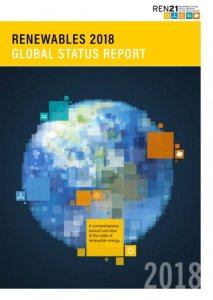
Renewable power generation capacity saw its largest annual increase ever, with an estimated 178 GW added globally, according to the Renewables 2018 Global Status Report.
Renewable power accounted for 70% of net additions to global power generating capacity in 2017, but global energy-related carbon dioxide emissions rose 1.4% in 2017, after three years of holding steady, according to a new report released by REN21.
The increase in carbon emissions was the result of robust global economic growth (of 3.7%), lower fossil-fuel prices and weaker energy-efficiency efforts, according to the Renewables 2018 Global Status Report (GSR). The report reveals two realities: one in which a revolution in the power sector is driving rapid change towards a renewable energy future, and another in which the overall transition is not advancing with the speed needed, said REN21 Chair Arthouros Zervos in the forward. While momentum in the power sector is positive, it will not on its own deliver the emissions reductions demanded by the Paris climate agreement or the aspirations of Sustainable Development Goal 7. The heating, cooling, and transport sectors, which together account for about 80% of global total final energy demand, are lagging behind, he said.
However, renewable power generation capacity saw its largest annual increase ever, with an estimated 178 GW added globally. New solar photovoltaic generating capacity alone was greater than additions in coal, natural gas, and nuclear power combined.
While China, Europe, and the United States accounted for nearly 75% of the global investment in renewable power and fuels, 2017 saw significant investment in developing country markets. When measured per unit of gross domestic product, the Marshall Islands, Rwanda, the Solomon Islands, Guinea-Bissau and many other developing countries are investing as much as or more in renewables than developed and emerging economies. These positive developments need to be scaled up for a global energy transition, Zervos said.
Read more about the report here.
Filed Under: News




